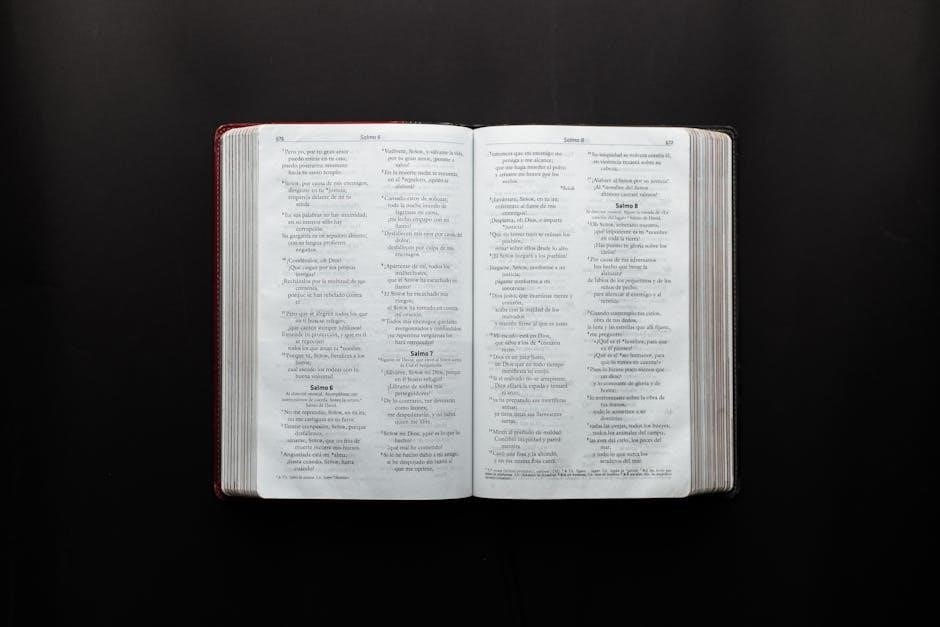The 10th edition of A Writer’s Reference is a trusted guide for college writers, offering updated resources for research writing in MLA, APA, and Chicago formats. With a focus on clarity, conciseness, and proper citation practices, it provides comprehensive support for academic writing needs. Available as both an e-book and print handbook, it integrates seamlessly with Achieve, Macmillan’s digital course experience, ensuring accessibility and convenience for modern learners.
Overview of the 10th Edition
The 10th edition of A Writer’s Reference is the latest update to a trusted resource for college writers, offering clear guidance on writing, research, and citation. It provides updated rules for MLA, APA, and Chicago styles, reflecting the most current academic standards. The edition introduces a tabbed layout for easy navigation, allowing users to quickly find relevant sections. It also includes expanded coverage of digital writing and multimedia sources, addressing the evolving needs of modern students. The 10th edition emphasizes critical skills such as clarity, conciseness, and proper citation practices, while also addressing common challenges like grammar, punctuation, and plagiarism. With both print and e-book formats available, it integrates seamlessly with digital tools like Achieve, Macmillan’s online learning platform. This edition is designed to support academic success, making it an indispensable tool for writers at all levels.

Importance of the Book for College Writers

A Writer’s Reference 10th Edition is an essential tool for college writers, providing clear and concise guidance on writing, grammar, and citation. It addresses common challenges such as clarity, conciseness, and proper citation practices, which are critical for academic success. The book’s tabbed layout and comprehensive coverage of MLA, APA, and Chicago styles make it a go-to resource for students navigating various writing assignments. Its emphasis on proper citation practices helps students avoid plagiarism, a key concern in academic writing. Additionally, the inclusion of digital tools and exercises supports interactive learning, catering to different learning styles. Whether used as a print handbook or e-book, the 10th edition equips writers with the skills and confidence to produce polished, professional work, making it a vital companion throughout their college careers.
Key Features of the 10th Edition
The 10th edition of A Writer’s Reference offers several innovative features designed to enhance the writing experience. Its groundbreaking tabbed layout allows for quick access to topics, ensuring that students can find information effortlessly. The book covers a wide range of subjects, including grammar, punctuation, and citation styles such as MLA, APA, and Chicago. Interactive learning tools and exercises are integrated to promote engagement and skill development. Additionally, the edition includes a companion e-book and access to Achieve, Macmillan’s digital platform, providing a seamless learning experience. These features make the 10th edition a comprehensive and accessible resource for writers at all levels, helping them refine their skills and meet the demands of academic writing with confidence and precision.

Content and Structure of “A Writer’s Reference 10th Edition”

The 10th edition features a tabbed layout, organizing content into clear sections like grammar, punctuation, and citation styles. Its structured design ensures clarity and accessibility for writers at all levels.
Tabbed Layout and Organization
The 10th edition introduces an innovative tabbed layout, allowing quick access to specific sections. Each tab represents a major category, such as grammar, punctuation, and citation styles. This design enhances navigation, making it easy for writers to find the information they need without flipping through pages. The sections are logically organized, with clear headings and concise explanations. For example, the grammar section includes detailed rules on verb tenses and common sentence structures; The citation styles are also neatly categorized, offering step-by-step guides for APA, MLA, and Chicago formats. This user-friendly approach makes the reference guide both efficient and accessible for students and professionals alike, ensuring that writers can focus on improving their craft rather than searching for information.
Topics Covered in the Handbook
A Writer’s Reference 10th Edition covers a wide range of essential topics to support college writers. It includes detailed guidance on grammar, punctuation, and sentence structure, with examples to clarify complex rules. The handbook also addresses research writing, offering step-by-step advice on finding and integrating sources. Citation styles for MLA, APA, and Chicago are thoroughly explained, with updated guidelines for digital sources. Additionally, it provides strategies for improving clarity and conciseness in writing, as well as tips for revising and editing. The book also includes sections on writing in different academic disciplines and addressing common writing challenges, such as avoiding plagiarism and understanding audience needs. With its comprehensive coverage, the handbook serves as an indispensable tool for writers seeking to refine their skills and produce polished, professional work.
Exercises and Interactive Learning Tools
A Writer’s Reference 10th Edition includes a variety of exercises and interactive learning tools designed to help students improve their writing skills. The handbook features practical exercises that allow writers to apply grammar, punctuation, and style rules in real-world contexts. Additionally, the digital version offers interactive activities, such as quizzes and self-assessment tools, to reinforce learning. These resources enable students to test their understanding of key concepts and identify areas for improvement. The exercises are often accompanied by clear explanations and examples, making it easier for learners to grasp complex ideas. Furthermore, the integration of Achieve, Macmillan’s digital platform, provides a dynamic environment for practicing and mastering writing skills. These tools make the handbook a comprehensive and engaging resource for writers at all levels, fostering both independent study and classroom instruction. The interactive elements ensure an active and effective learning experience.

Citing Sources in “A Writer’s Reference 10th Edition”
The 10th edition provides comprehensive guidance on citing sources in APA, MLA, and Chicago styles, with detailed examples for digital sources like PDFs and updated research practices.

APA Style for PDFs
APA Style does not provide a specific citation format for PDFs but requires identifying the source type (e.g., book, article, or report) and citing it accordingly. For PDFs, include the author, publication year, title, and URL or DOI. If the PDF is a book chapter, use “Chapter” in italics and specify the edition. Journal articles in PDF format should include the journal name, volume, issue, and page range or e-locator. Dissertations and theses in PDFs are cited with the title, degree type, university, and repository URL. Reports and white papers include the publisher and URL. Always check for updates in the A Writer’s Reference 10th Edition for precise APA guidelines.
MLA Style for PDFs
MLA Style recommends citing PDFs similarly to print sources, identifying the type of work (e.g., article, book chapter, or report). Include the author, title, publication details, and page numbers if available. For PDFs without page numbers, use paragraph numbers prefixed with “par.” If citing a standalone PDF, treat it as a book or report, including the title in italics. When accessed online, add the URL or DOI at the end. If the PDF is part of a larger work, use a container format, listing the title of the PDF in quotes, followed by the title of the container in italics, and the URL or DOI. The A Writer’s Reference 10th Edition provides detailed MLA guidelines for citing digital sources like PDFs accurately and effectively.
Chicago Style for PDFs
Chicago Style offers two citation systems: author-date and notes-bibliography. For PDFs, the approach depends on the source type. If citing a book or book chapter in PDF format, include the author, title, publication details, and URL or DOI. For journal articles in PDFs, follow the standard Chicago citation format for journal articles, adding the URL or DOI at the end. If the PDF lacks page numbers, use chapter or section titles to locate the reference. When citing a standalone PDF document, treat it as a book or report, including the title in italics. The A Writer’s Reference 10th Edition provides clear examples for citing digital sources in Chicago Style, ensuring proper formatting and academic integrity. Always include the URL or DOI to ensure readers can access the source online.

Using the PDF Version Effectively
The PDF version of A Writer’s Reference offers enhanced accessibility and flexibility. With search functions and navigation tools, users can quickly locate specific topics and exercises. The digital format allows for easy highlighting, annotating, and bookmarking, making it ideal for interactive learning. Additionally, the PDF is accessible on multiple devices, enabling seamless study anywhere. Its portability and user-friendly design make it a valuable resource for both in-class and remote learning environments.
Advantages of the Digital Format
The digital format of A Writer’s Reference 10th Edition offers numerous advantages for students and writers. Accessible on multiple devices, it allows for seamless study anywhere, enhancing flexibility and convenience. The PDF version is easily searchable, enabling quick navigation to specific topics, exercises, and examples. Users can highlight and annotate pages, facilitating active engagement and personalized learning. Additionally, the digital format is environmentally friendly, reducing the need for physical materials. The integration with Achieve, Macmillan’s digital platform, provides interactive tools and resources, such as quizzes and practice exercises, further enriching the learning experience. These features make the digital version a powerful and practical resource for academic success, catering to diverse learning styles and preferences. Its portability and accessibility ensure that students can utilize it effectively in various settings, from classrooms to home environments.
Navigation and Search Functions
The digital version of A Writer’s Reference 10th Edition features robust navigation and search functions, making it easy for users to locate specific content quickly. The PDF format includes a detailed table of contents with interactive links, enabling users to jump directly to desired sections. A built-in search function allows learners to find keywords, topics, or examples instantly, streamlining the learning process. Additionally, users can bookmark frequently referenced pages and highlight important sections for easy retrieval. These tools enhance productivity and ensure that writers can access the guidance they need without delay. The intuitive design supports a seamless user experience, making it an invaluable resource for academic and professional writing tasks. The ability to navigate and search efficiently saves time and fosters a more focused approach to improving writing skills.
Accessibility Features
The A Writer’s Reference 10th Edition PDF is designed with accessibility in mind, ensuring that all learners can benefit from its resources. The digital format includes features such as adjustable font sizes and high-contrast display options, making it readable for users with visual impairments. Additionally, the PDF is compatible with screen readers, allowing individuals with disabilities to navigate the content seamlessly. The structure follows clear headings and alt-text for images, enhancing accessibility further. These features ensure that the handbook is inclusive and provides equal access to its comprehensive writing guidance. By prioritizing accessibility, the 10th edition supports diverse learning needs, making it a valuable tool for all writers, regardless of their abilities. This inclusive approach reflects a commitment to providing high-quality resources for every student.

Common Writing Challenges Addressed
The 10th edition tackles clarity, conciseness, grammar, punctuation, and plagiarism, offering practical solutions to common writing struggles. It equips writers with tools to refine their craft effectively.
Clarity and Conciseness in Writing
A Writer’s Reference 10th Edition PDF emphasizes the importance of clear and concise writing. It provides practical strategies to eliminate wordiness and ensure that ideas are expressed directly. The guide offers tips on avoiding vague language, using active voice, and structuring sentences for maximum impact. Additionally, it includes exercises to help writers identify and revise overly complex sentences. By focusing on clarity, writers can enhance the readability of their work and effectively communicate their message. The 10th edition also addresses common pitfalls, such as redundant phrases and unnecessary jargon, helping writers refine their style. With its comprehensive approach, this edition empowers writers to produce clear, engaging, and professional text.
Grammar and Punctuation Guidelines

A Writer’s Reference 10th Edition PDF provides detailed guidance on grammar and punctuation, essential for effective writing. It offers clear explanations of complex rules, such as subject-verb agreement, pronoun usage, and comma placement. The guide includes practical examples to illustrate common errors and their corrections. Additionally, it covers punctuation marks like semicolons, colons, and apostrophes, ensuring writers understand their proper use. The book also addresses modern grammatical challenges, such as gender-neutral pronouns and sentence structure in digital communication. With interactive exercises and reference charts, it helps writers refine their skills and avoid mistakes. By focusing on precision and clarity, the 10th edition empowers writers to produce grammatically sound and polished text, making it an invaluable resource for students and professionals alike.
Plagiarism and Proper Citation Practices
A Writer’s Reference 10th Edition PDF emphasizes the importance of proper citation practices to avoid plagiarism. It provides clear guidelines for citing sources in MLA, APA, and Chicago formats, ensuring academic integrity. The guide explains how to paraphrase effectively and when to use direct quotes. It also covers how to identify and cite digital sources, such as PDFs, accurately. Interactive exercises help writers practice incorporating sources seamlessly into their writing. The book stresses the ethical implications of plagiarism and offers practical strategies to avoid it. With detailed examples and updated resources, it serves as a comprehensive tool for understanding proper citation practices, helping writers maintain originality and give credit where it’s due. This focus ensures that students can produce authentic, well-supported academic work with confidence.
The 10th edition of A Writer’s Reference is a comprehensive guide, offering invaluable insights and resources for students and writers. Updated for modern writing needs, it remains an essential tool for success.
Final Thoughts on the 10th Edition
A Writer’s Reference 10th Edition stands out as a vital resource for students and writers, offering clear guidance on writing, research, and citation. Its tabbed layout and digital features enhance accessibility, making it easier to navigate and apply its comprehensive advice. The inclusion of exercises and interactive tools fosters a deeper understanding of key concepts, while the focus on proper citation practices helps prevent plagiarism. With its balanced approach to traditional and modern writing challenges, this edition remains an indispensable companion for anyone seeking to improve their writing skills and meet academic expectations. Its adaptability to various learning styles and formats ensures it continues to be a trusted reference for years to come.
Recommendations for Students and Writers
Students and writers are highly encouraged to utilize A Writer’s Reference 10th Edition for its comprehensive guidance on improving writing skills and adhering to academic standards. The handbook’s clear explanations and practical examples make it an ideal resource for navigating complex writing challenges. Its focus on proper citation practices in MLA, APA, and Chicago styles ensures that users can maintain academic integrity. Additionally, the interactive exercises and digital tools provide hands-on opportunities to enhance writing proficiency. Whether for academic assignments or personal projects, this edition is a valuable tool for anyone aiming to refine their writing and research skills. By incorporating this reference into their workflow, students and writers can confidently produce polished, well-supported work.
